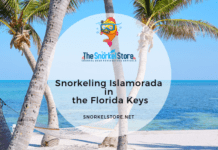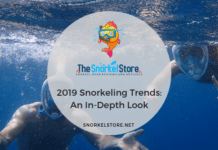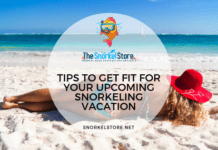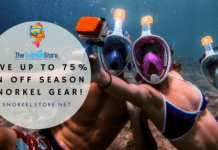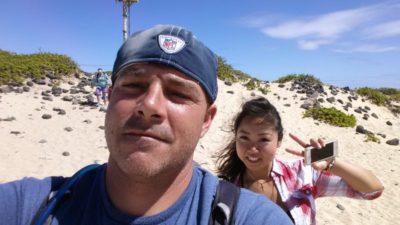Last Updated on July 8, 2024 by Snorkel Ken

We love snorkeling in the Florida Keys. Being stationed at Fort Gordon, GA these days, Lizzy and I are closer to the Keys than the Hawaiian Islands. (But that’s nothing to complain about, right? #firstworldproblems indeed).
Contents
Any discussion about “where is the best snorkeling (or diving) in the Florida Keys” needs to first ensure that the reader understands the geography of the Keys themselves.
This may be a bit of longer content for us, here, so let’s jump in right away.
Did You Know where the word “Key” comes from?
A cay is a naturally occurring low island, either a sandbar or a coral reef. Cay is most often applied to Caribbean islands, the preferred pronunciation is “key” Cay comes from the Spanish word, “cayo”, which means key. Its first use to refer to an island occurred in 1707.
The Florida Keys, Defined and Explained
There are so many Islands in the Keys (over 1000!) that they had to further broken down into 3 different locality groups:
- The Upper Keys
- The Middle Keys
- The Lower Keys

Notable Northern or Upper Keys Interests to Understanding
The very, very northern section of the Upper Keys is south of the city of Miami is Biscayne National Park. Now, here’s where it gets a little confusing to people who don’t really know about the geography. The
FIRST island that begins the Keys, the “uppermost” upper Island is Key Largo. Though there are several small islands between Biscayne National Park and Key Largo, these islands are NOT part of the Keys but a part of the national park itself.
And here is the other snorkeler’s dream fact: 90% of Biscayne National Park is UNDERWATER!! It is chock full of coral reefs, gorgeous water and those small islands. An awesome ecosystem of southern Florida wildlife occur, survive and thrive in the park due to the abundance of shelter, nesting locations, and natural resources of food.
Here is a list of Islands located between within Biscayne National Park and Key Largo
- Elliott Key.
- Reid Key.
- Rubicon Keys.
- Totten Key.
- Rhodes Key.
- Soldier Key.
- Ragged Keys
- Boca Chita Key and Island
- Sands Key.
The most popular of these Keys is Boca Chita Island which is home of the Boca Chita Lighthouse which attracts many visitors and is the most well known of the Biscayne National Park Islands)

Now Let’s Get into the Upper Keys
Closest to Miami are the Upper Keys and within Monroe County. Key Largo is on the northern side of the Keys and a MAJOR tourist attraction. It has the top reputation as having the best and most interesting diving and snorkeling spots of the keys. And why not? This section of the Florida Keys shares a part of Everglades National Park and just a bit south of Key Largo Islamorada, the “fisherman town” of fame.
The Upper Florida Keys
- Key Largo (North Key Largo, Key Largo and Tavernier)
- Tavernier (We’ll give Tavernier its own bullet here but it’s not an actual island. Instead it is an awesome part of Key Largo)
- Plantation Key.
- Windley Key.
- *Islamorada-The Village of Islands and Sport Fishing Capital of the World. Islamorada has its own group of Islands (that are part of the Keys). They include: Plantation, Lower Matecumbe, as well as Indian and Lightnumvitae Keys)
- Upper Matecumbe Key.
- Lower Matecumbe Key.
Did You Know?
Lightnumvitae Key and Indian Key contain Botanical State Parks and other Historic Sites and form part of the “Triangle of History”. Both are on either side of the Matecumbe Keys and US 1…accessible only boat.
- Ken’s Personal Note: US 1f feels like the longest road in human history at times when driving this route.
- Lizzy’s Personal Note: *eye roll
The Middle Florida Keys
Can you guess where the “middle” Keys are? Yup. They’re in the center section of our 3 categories of Keys. The Middle Keys contain many islands, but most notable are the Marathon Island group and the Pigeon Key which is a historic notable and can been from US 1 while on the dreaded 7 Mile Bridge.
- The Marathon Islands which include Grassy, Crawl, Long Point, Fat Deer, Shelter, Boot, Vaca, and Knight’s Key)
- Pigeon Key
- Craig Key.
- Fiesta Key.
- Long Key.
- Conch Key.
- Duck Key.
- Grassy Key.
- Crawl Key.
- Long Point Key.
- Fat Deer key.
- Shelter Key.
- Vaca Key.
- Boot Key.
- Knight’s Key
The Lower Florida Keys

Aaah, the Lower Keys. Here is where we get nice and exotic with the not only LOTS of Islands over a vast area of the Southernmost point of the United States but also included are the festive locations of Key West. The islands included in the lower Florida Keys include:
- Little Dock Key
- Missouri Key
- Sunshine Key
- Bahia Honda Key (Home of the of the AWESOME Bahia Honda State Park and gorgeous Beaches)
- Spanish Harbor
- Scout Key or Summerland Key
- No Name Key
- Big Pine Key
- Little Torch Key
- Meddle Torch Key
- Big Torch Key.
- Ramrod Key
- Summerland Key
- Knockemdown Key
- Cudjoe Key
- Sugarloaf Key
- Park Key
- Lower Sugarloaf Key
- Saddlebuch Key
- Shark Key
- Geiger Key
- Big Coppitt
- Rockland Key
- Boca Chita Key
- Racoon Key
- Stock Island
- Key West (So much has been written about Key West that we’ll touch on it just a bit in later content)
- Sisgbee Park
- Fleming Key
What Comes After the Lower Florida Keys?
Beyond the southernmost Florida Keys we have outlying Islands that are only accessible by watercraft and sea plane from Key West. These locations include:
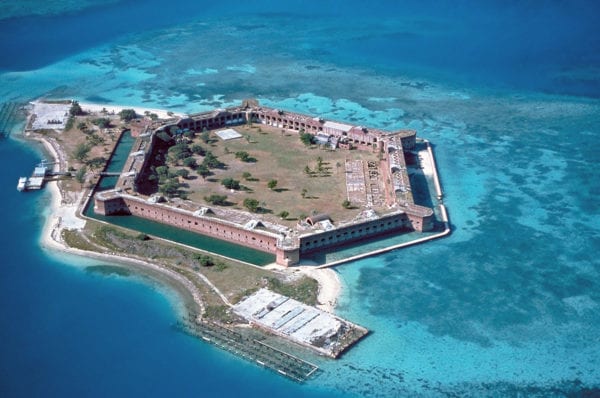
- Dry Tortugas which houses, Fort Jefferson, the largest structure of masonry design in the Western Hemisphere. (Part of Dry Tortugas National Park)
- Marquesas Islands
- Sunset Key along with Wisteria Island
Okay, so that’s our intro the make up of the Florida Keys which we feel was important to explain before we start getting into an article about the best snorkeling spots in the areas.
10 Great Snorkeling Spots in the Florida Keys
Fort Zachary Taylor, Key West

Not only is the surrounding area decked out with everything that you need such as a great café, nature trails and guided tours of Ft Zachary Taylor (built in 1866), this location offers a great chance to get acquainted with the local marine life.
While mostly a beginner’s location for snorkeling, any snorkeler can get a great experience, lots of fun and some awesome images in the clear, calm, gorgeous waters. The beach is pretty well accepted as the best in Key West and is located at the southernmost tip of the Key.
Good, live coral with plenty of marine life. Bring your favorite pair of snorkel gear or rent it with cash right on location.
Fort Jefferson, Dry Tortugas

This would probably be number one on our list if it was easier to get to. It is by far a superior snorkeling location but is only accessible by ferry or sea plane as it is 70 miles off of Key West. Dry Tortugas is a beautiful park and the surrounding waters are crystal clear. This is perfect for a day trip while on vacay.
There are a lot of great mini locations to dive or snorkel at Dry Tortugas, including: Windjammer, Little Africa, Texas Rock, the Pulaski Shoals area and the opportunity to snorkel at night along the Moat Wall.
Read about our night snorkeling adventure with manta rays on the Big Island, Hawaii here.
John Pennekamp Coral Reef State Park, Key Largo

This is one of the best locations for a guided snorkeling tour in the Florida Keys. This was the USA’s first underwater park and spans a whopping 70 nautical miles. You can even take a nice easy swim out to a ship wreck at Cannon Beach (“easy swim” is relative. Always monitor your abilities, your fatigue, and note the snorkeling safety guidelines.)
As stated a second ago, the highlight here are off-shore, guided snorkel tours with local experts. They are simply awesome.
Among the living corals and marine life you’ll be able to see a bunch of turtles, butterfly fish, angel fish and parrot fish.
Coffins Patch, Key Colony Beach

Want some great snorkeling that is offshore and in some of the bluest, calmest waters around? Then grab a tour of Coffins Pats, 4 nautical miles from Key Colony Beach. This is perhaps the best snorkeling in the middle Keys. Many people don’t agree, but we challenge you to find better than Coffin’s Patch. The water quality an location reminds me a lot of Molokini Crater off of Maui (sans the big crater…).
Interesting about this location is that it is the spot of a sunken Spanish ship, the Ignacio in the 18th century.
Elliott Key, Biscayne National Park

Inside the beautiful Biscayne National Park in the upper Keys, is Elliot Key. Got a boat? No? Get one! Why? Because if you don’t have one (or get a guide tour to and around the location) you’ll miss all of the beautiful reefs and shipwrecks.
Again, you’re only going to be able to get here by boat but is WELL WORTH the effort. The shipwrecks are just east of the Key and along the Maritime Heritage Trail.
Alligator Reef Lighthouse, Islamorada

First, the good news: There are no alligators. Yay. And there was much rejoicing… But, if you’re visiting Islamorada, then you’re just three miles from the ‘Gator Reef. You can easily get an affordable charter out to the lighthouse.
Once at the reef you’ll get the chance to see lots and lots of marine life. Parrotfish, barracuda (like the song!) turtles and rays (oh my!). How deep you ask? About 20 feet on average in clear water. That equals awesome visibility. Don’t forget to bring the GoPro or your other underwater camera.
Sombrero Reef, Marathon

Do you want a shallow reef? How about 2 to 30 feet? 2 feet is a very shallow reef. This is absolutely one of the easiest and best reefs to observe. The water is a rich blue and the reef at Sombrero looks great against the dark backdrop. Tons of tropical fish and marine life.
Bahia Honda State Park, Big Pine Key

If you want to camp at Bahia Honda State Park, then you better be ready to prepare, reserve and defend your location. These are some of the most coveted campsites in the state of Florida’s park system.
Oh, and those campsites, they’re literally (channeling my inner Chris Traeger here) just feet away from the best snorkeling spots in the Keys.
Calm seas, clear water of 4 to 6 feet and an optimal place for kids, beginners and experienced snorkelers. Some of the best snorkeling I ever did was at places like this; easy to enter the water and convenient to lounge in the sun when not getting wet.
What will you see? Soft corals, sponges, small coral heads, stone crabs and even the occasional spiny lobster. Yum.
Key Largo Dry Rocks, Key Largo

This is an offshore excursion that is east of another location on this list, the John Pennekamp Coral Reef State Park. There is a world famous dive statue to be seen at this location, the Christ of the Abyss Statue that was purposely sunk in the location in 1965. It stands in 25 feet of water and is surrounded lots of marine life and tropical fish.
The area sits in the Key Largo Existing Management Area which was known previously as the Key Largo National Marine Sanctuary.
Looe Key National Marine Sanctuary, Big Pine Key
Okay, so for all of you divers reading this, you can relax. Yes. This is more of a dive area as it sits in 100 feet of water and is within the Florida Keys National Marine Sanctuary. You can get a glimpse of eagle rays, eels, sharks (lemon and reef), sergeant majors, grouper, and lots of other stuff.
Other Notable Facts:
- Key West is home to the only living barrier reef in the continental United States.
- Most places offer great guided tours.
We hope you enjoyed and maybe even learned a little bit more about the Florida Keys prior to your visit. As always, if you have questions or comments then feel free to reach out in the comments or via the contact page or Facebook.
Thanks. Snorkel Safe.
Ken & Lizzy

